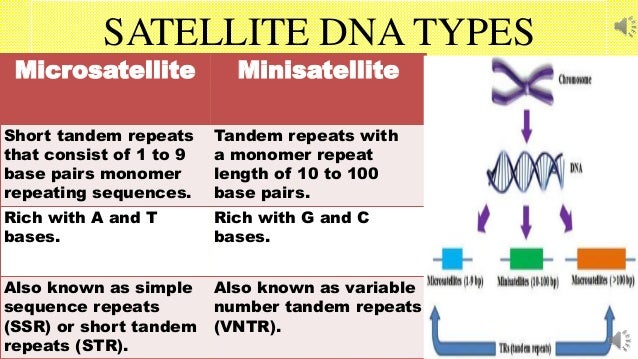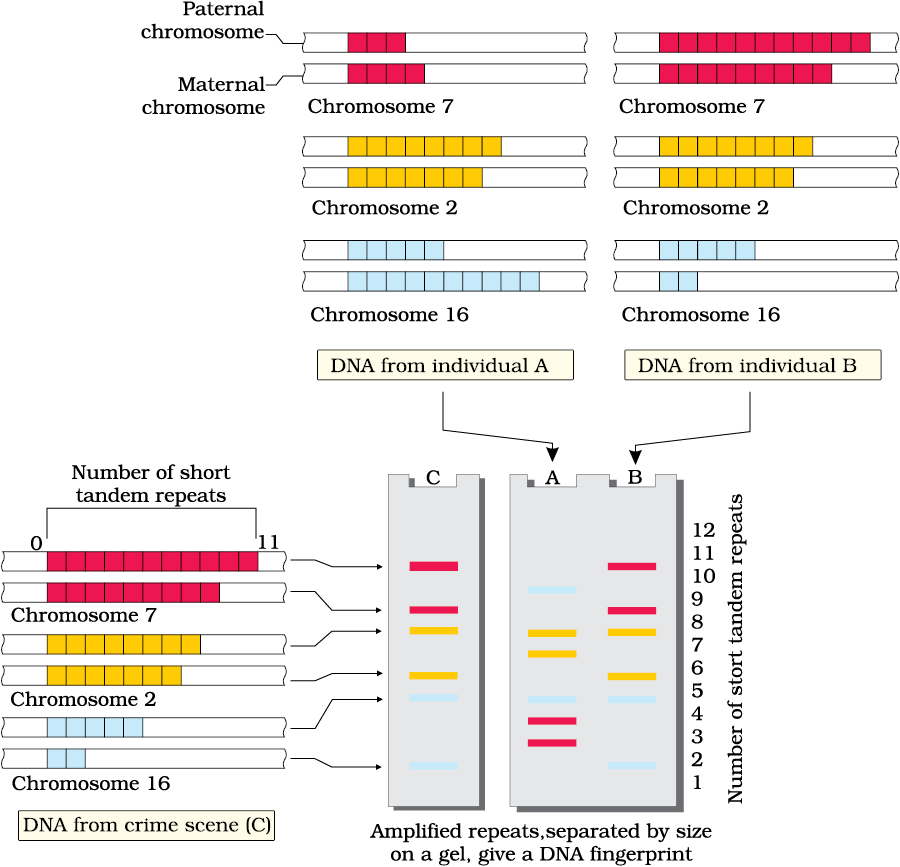6.10 DNA FINGERPRINTING
6.10 DNA FINGERPRINTING
- DNA fingerprinting is a very quick way to compare the DNA sequences of any two individuals.
- DNA fingerprinting involves identifying differences in some specific regions in DNA sequence called as repetitive DNA, because in these sequences, a small stretch of DNA (TANDEM REPEATS) is repeated many times.
Satellite DNA
- Repetitive DNA are separated from bulk genomic DNA as different peaks during density gradient centrifugation.
- The bulk DNA forms a major peak and the other small peaks are referred to as satellite DNA.
- Depending on base composition (A : T rich or G:C rich), length of segment, and number of repetitive units, the satellite DNA is classified into many categories, such as micro-satellites, mini-satellites etc.

POLYMORPHISM & POLYMORPHIC DNA
- Polymorphism is a variation at genetic level
- Arises due to mutations
- Such mutation in germ cells (sperm/egg) inheritable if it does not impair once reproductive ability
- if an inheritable mutation is observed in a population at high allelic frequency (greater than 0.01), it is referred to as DNA polymorphism.
- These mutations keep on accumulating generation after generation, and form one of the basis of variability/polymorphism.
- They can be SNPs- single nucleotide polymorphism or VNTR- Variable number of tandem repeats
- polymorphisms play very important role in evolution and speciation
Explanation of the above
- Repetitive DNA sequences normally do not code for any proteins, but they form a large portion of human genome.
- Repetitive DNA sequence show high degree of polymorphism and form the basis of DNA fingerprinting.
- Since DNA from every tissue (such as blood, hair-follicle, skin, bone, saliva, sperm etc.), from an individual show the same degree of polymorphism, they become very useful identification tool in forensic applications.
- Further, as the polymorphisms are inheritable from parents to children, DNA fingerprinting is the basis of paternity testing, in case of disputes.
- As polymorphism in DNA sequence is the basis of genetic mapping of human genome as well as of DNA fingerprinting, it is essential that we understand what DNA polymorphism means in simple terms.
- Polymorphism (variation at genetic level) arises due to mutations. (Recall different kind of mutations and their effects that we have already studied in Chapter 5, and in the preceding sections in this chapter.)
- New mutations may arise in an individual either in somatic cells or in the germ cells (cells that generate gametes in sexually reproducing organisms).
- If a germ cell mutation does not seriously impair individual’s ability to have offspring who can transmit the mutation, it can spread to the other members of population (through sexual reproduction).
- Allelic (again recall the definition of alleles from Chapter 5) sequence variation has traditionally been described as a DNA polymorphism if more than one variant (allele) at a locus occurs in human population with a frequency greater than 0.01.
- In simple terms, if an inheritable mutation is observed in a population at high frequency, it is referred to as DNA polymorphism.
- The probability of such variation to be observed in noncoding DNA sequence would be higher as mutations in these sequences may not have any immediate effect/impact in an individual’s reproductive ability.
- These mutations keep on accumulating generation after generation, and form one of the basis of variability/polymorphism.
- There is a variety of different types of polymorphisms ranging from single nucleotide change to very large scale changes.
- For evolution and speciation, such polymorphisms play very important role, and you will study these in details at higher classes.
STEPS INVOLVED IN DNA FINGERPRINTING
- The technique of DNA Fingerprinting was initially developed by Alec Jeffreys.
- He used a satellite DNA as probe that shows very high degree of polymorphism.
- It was called as Variable Number of Tandem Repeats (VNTR).
- The technique, as used earlier, involved Southern blot hybridisation using radiolabelled VNTR as a probe.
It included
- (i) isolation of DNA,
- (ii) digestion of DNA by restriction endonucleases,
- (iii) separation of DNA fragments by electrophoresis,
- (iv) transferring (blotting) of separated DNA fragments to synthetic membranes, such as nitrocellulose or nylon,
- (v) hybridisation using labelled VNTR probe, and
- (vi) detection of hybridised DNA fragments by autoradiography.
VNTR
- The VNTR belongs to a class of satellite DNA referred to as mini-satellite.
- A small DNA sequence is arranged tandemly in many copy numbers.
- The copy number varies from chromosome to chromosome in an individual.
- The numbers of repeat show very high degree of polymorphism.
- As a result the size of VNTR varies in size from 0.1 to 20 kb.
- Consequently, after hybridisation with VNTR probe, the autoradiogram gives many bands of differing sizes.
- These bands give a characteristic pattern for an individual DNA (Figure 6.16).
- It differs from individual to individual in a population except in the case of monozygotic (identical) twins.
- The sensitivity of the technique has been increased by use of polymerase chain reaction (PCR).
- Consequently, DNA from a single cell is enough to perform DNA fingerprinting analysis.
- In addition to application in forensic science, it has much wider application, such as in determining population and genetic diversities.
- Currently, many different probes are used to generate DNA fingerprints

Q/A
1. What is DNA fingerprinting? What does it identify?
2. What is satellite DNA? What is it made up of?
3. Differentiate between micro & mini satellite DNA.
4. Define polymorphism. What are the significance/characteristics of polymorphic DNA?
5. What forms the basis of DNA fingerprinting and evolution?
6. DNA polymorphism forms the basis of evolution. justify the statement.
7. The technique of DNA Fingerprinting was initially developed by ?
8. Briefly explain VNTR.
9. Briefly explain the steps involved DNA fingerprinting.
10. DNA polymorphism become very useful identification tool in forensic applications. why?
Comments
Post a Comment